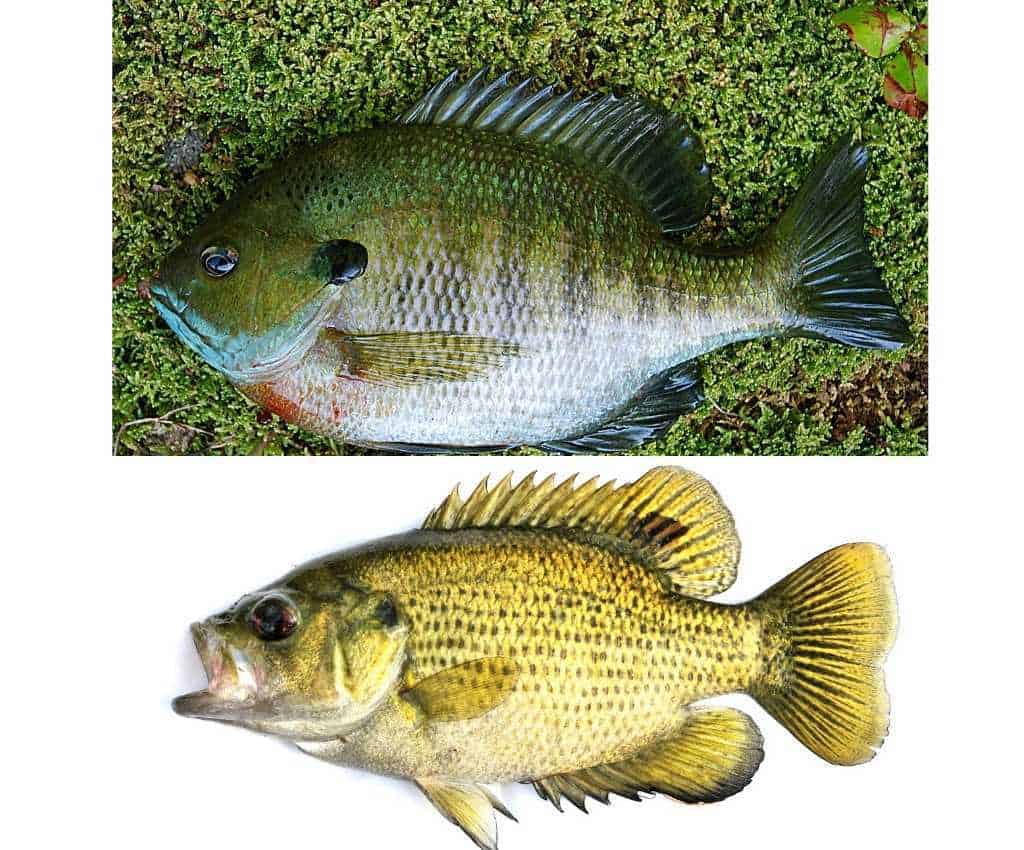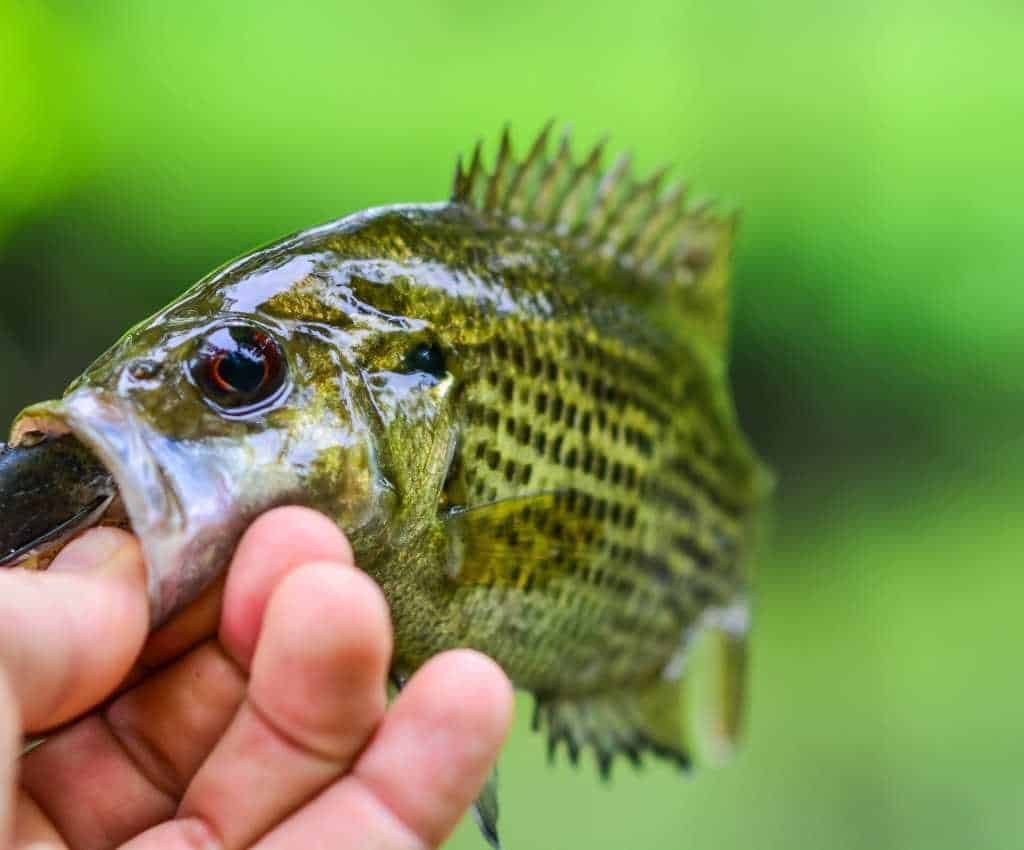Rock Bass vs Bluegill – What’s the Difference? Panfish
Rock bass and bluegill share many similarities. For this reason many people ask if they’re the same fish or different. Therefore, let’s answer, is a rock bass the same as a bluegill?
Rock bass and bluegill are different species of fish although they are from the same family. Rock bass is the A. Rupestris and bluegill is the L. macrochirus species. The most identifiable difference is the rock bass bright red or orange eye color compared to the bluegill’s dark eyes.
This article will compare both fish tastes, textures, cooking methods, costs, mercury levels and whether one can substitute for the other in recipes. In addition, I’ll do a side-by-side comparison of their habitats, appearance and compare their nutritional value.
Rock Bass vs Bluegill: Habitats, Size, Weight and Appearance
How can you tell the difference between the two fish?
To tell the difference between a rock bass and bluegill is to check their cheeks, belly colors and dorsal fins. Bluegill have blue color on the sides of their mouth and chin. Rock bass has no blue, just a dark tear drop below their eyes. Bluegill has an orange belly compared to rock bass white/silvery belly. Bluegill has a dark spot on the base of the dorsal fin rock bass doesn’t have.

Other ways to tell the difference:
- Bluegill has a rounder body with the mouth more streamlined with the body. Rock bass has an elongated body with the mouth more pointier.
- Rock bass has 5-7 anal fin spines, bluegill has 3 anal fin spines.
- Rock bass has teeth in the mouth, bluegill has no teeth.
- Rock bass has red or orange eyes, bluegill has dark eyes.
- Bluegill has a small mouth, rock bass has a large mouth.
- Rock bass has dark spots forming laterals lines, bluegill has no lateral lines but vertical bars.
Rock Bass and Bluegill Scientific Classifications, Families, Species
Bluegill are from:
- Family: Centrarchidae
- Genus: Lepomis
- Species: L. macrochirus
- Common nicknames: Bream, panfish, brim, sunny, sunnies, perch.
Rock bass are from:
- Family: Centrarchidae
- Genus: Ambloplites
- Species: A. rupestris
- Common nicknames: Red eye, rock perch, goggle eye.
Both species are part of the sunfish family. Other fish include smallmouth bass, largemouth bass, pumpkinseed, warmouth and crappies.
Habitats
Bluegill
- Native to North America and can be found from Canada, Delaware to northern Mexico.
- When fishing they can be found in streams, ponds, lakes and rivers.
- They like to hide under fallen logs, piers or in weeds.
Rock Bass
- Native to North America and can be found from Canada down to Florida and west to Texas. They are mostly found in the eastern and central United States.
- When fishing they can be found in streams, ponds, lakes and rivers.
- The species prefer rocky shorelines and vegetation areas. They can be found under docks and near swimming areas.
Appearance
Colors
- Bluegills have an olive green upper body and light yellowish to orange belly. The sides of the head and chin are iridescence blue or purple. The fish have dark vertical bands on the sides. A breeding male will have more orange than yellow on the belly.
- Rock bass have an olive green to golden brown upper back and sides fading down to a silvery, white belly. The species have black spots which form broken lateral stripes down the body. The have red eyes and the fish has the ability to change colors to match their surroundings for protection.
Dorsal Fins
- Bluegill has one dorsal fin with 6-13 spines and 11-12 rays.
- Rock bass has one dorsal fin with about 10-13 spines followed by 11-13 rays.
Anal Fins
- Bluegill has three anal spines followed by 10-12 rays.
- Rock bass has 5-7 anal spines followed by 10-12 rays.
Mouth
- The bluegill mouth is small, and the jaw doesn’t extend to the eye line. They don’t have teeth.
- The rock bass mouth is large located below the snout. They also have teeth.
The rock bass has a pointier snout compared to the bluegill which has a more streamlined mouth and head which blends into the body. A big difference between the two fish is their mouth size.
Body Shape
- Bluegill are flat and have a rounder shape. The mouth hardly protrudes and is more streamlined.
- Rock bass are flat and not round. They are more elongated.
Size and Weight
- Bluegill average 6-7″ long and weighs less than 2 pounds.
- Rock bass average 6-10″ long and weighs about one pound.
Lifespan
- Bluegill average 5-6 years.
- Rock bass lives up to 8-10 years.
Diet
Bluegill consume the following:
- Worms
- Small crustaceans
- Insects
- Insect larvae
Rock bass consume the following:
- Smaller fish
- Insects
- Worms
- Small crustaceans
- Minnows
Both fish have a similar diet.

Bass Fishing
When looking at the sunfish family, rock bass fishing won’t win many popularity contests amongst anglers. Despite their gamefish appeal, when fishing they are strangely appealing.
They can get caught with almost any angling method. Live bait works extremely well. Bass fishing within a few feet of the bank is best.
Prior to fishing, always check with your local advisory, safety and management boards.
I recently wrote a comparison article with the species pumpkinseed. Their differences may interest you. Check out my comparison article here.
Panfish: Tastes and Textures
One of the most important things people takes into consideration when fishing or choosing a fish is its taste. When comparing the two fish, rock bass vs bluegill, does one taste like the other?
Rock bass taste similar to bluegill and has a mild to sweet taste. Rock bass and bluegill have a firm, flakey texture.
Rock bass is good eating and tastes pleasing to most people having a mild to sweet taste. The white flesh is slightly firm and flakey.
Depending on the time of year or type of water when fishing, both may taste slight muddy or fishy to some people. The fish can be soaked in milk to help eliminate any unpleasant taste or odor.
To conduct some original research, I polled clients, readers and people in food groups. I asked which one tastes better?
- 39% said they preferred the taste of bass rock.
- 34% said they preferred the taste of bluegill.
- 27% said they had no preference one over the other.
To conduct more research, I set up a taste test at home. Both fish were cooked the same way with the same seasonings. Three out of four people chose the rock bass.
Substitutions
When preparing recipes for dinner it’s not always possible to locate the type of fish in the store or when fishing. If you only caught one type of fish when fishing, you may ask, can I substitute one for the other?
Rock bass and bluegill can substitute for each other due to their similar tastes and textures. Both fish can be used in many of the same recipes and cooking methods. They both can be cooked by baking, broiling, steaming, grilling, deep frying and pan frying.
Bluegill substitutes:
- White crappie
- Black crappie
- Pumpkinseed
- Redbreast sunfish
- Redear sunfish
- Pollock
- Lake herring
Rock bass substitutes:
- White crappie
- Black crappie
- Pumpkinseed
- Green sunfish
- Lake herring
- Tilapia
- Pollock
Find out how green sunfish compared in my article, Green Sunfish – What’s The Difference?

Costs
The costs for some fish will vary depending on the type of fishing and where they’re sold. When purchasing any fish, be sure to check the label. Therefore, which fish is more expensive?
Rock bass and bluegill have a similar price. The average cost for either ones fillets are $19.43 per pound.
Rock bass fillets are extremely difficult to find for sale. Sunfish are easier to find online.
To conduct more original research for fish prices, I checked online at Walleye Direct and found the following:
- Wild, bluegill fillets
- $25.36 per pound
Seafood Markets:
- Wild, sunfish fillets (does not specify which kind of sunfish)
- $18.00 per pound
Dixon Fisheries:
- Bluegill fillets
- $14.95 per pound
For stocking ponds, Pond King has the following price per live fish:
- Hybrid (green sunfish x bluegill) $0.75 per 3-4″ fish
- Bluegill – $0.75 per 3-4″ fish
Crappie is a little easier to find online than some of the other sunfish. See how crappie compared in my article, Crappie – What’s The Difference? Let’s Compare.

Mercury Levels
The EPA and The FDA have issued suggestions and warnings about mercury levels in fish and how often they should be consumed1. This is especially important for young infants, pregnant women and developing children.
They established three lists:
- Best fish
- Good choices
- Ones to avoid based
Therefore, which of the two fish has more mercury?
Rock bass and bluegill have similar levels of mercury. Both fish are listed on the FDA’s best choice of fish regarding mercury levels.
If you’re pregnant, breast feeding or has a young child, Always check with a physician prior to eating new foods or changing your dietary habits.
These mercury warnings can change over time or affect only a particular area or state. Please check with your local EPA and FDA for the current fish recommendations especially when fishing2.
Nutrition
Both of them are an excellent source of protein, healthy fats, minerals and B vitamins. Both sunfish contain the following:
- Omega-3 fatty acids
- Magnesium
- Potassium
- Folate
- Niacin
- B6
- B12
- B5
- Thiamin
- Riboflavin
- Iron
- Selenium
- Calcium
- Zinc
Bluegill provides the following number of nutrients per four raw ounces:
| Nutrient | Bluegill, raw (4 Ounces) |
| Calories | 129 |
| Fat | 0.8 g |
| Saturated Fat | 0.5 g |
| Cholesterol | 97 mg |
| Protein | 22 g |
| Sodium | 82 mg |
| Omega-3 | 0.16 g |
| B-6 | 0.1 mg |
| B-12 | 2.0 mcg |
| Thiamin | 0.10 mg |
| Riboflavin | 0.10 mg |
| B5 | 0.7 mg |
| Iron | 1.7 mg |
| Niacin | 1.4 mg |
| Folate | 17.0 mcg |
| Potassium | 395 mg |
| Magnesium | 34 mg |
| Phosphorus | 203 mg |
| Calcium | 90.4 mg |
| Zinc | 1.6 mg |
| Selenium | 14.2 mcg |
Both fish provide a similar percentage of the same nutrients. Keep reading the next section below to find out how the nutrients benefit health, especially omega-3s.
Since the sunfish are difficult to locate in stores, I’ll consume either fish available to me for their nutrient content, taste and health benefits.
Find out how redbreast sunfish compared in my article, Redbreast Sunfish – What’s The Difference?
Rock Bass and Bluegill Health Benefits
Omega 3 Fatty Acids
The omega-3 fatty acids are heart healthy and help keep arteries healthy. The omega-3s may help with the following:
- Reduce inflammation.
- Reduce plaque buildup.
- Keeping bad cholesterol low.
- Keeping good cholesterol high.
- Lowering triglycerides
- Help keep the heart rhythms more normal.
DHA and EPA, two of the fatty acids, are associated with lowering blood pressure and improving the health of blood vessels ((National Center for Biotechnology: Marine Omega-3 Supplementation and Cardiovascular Disease)).
Studies suggest omega-3s from fish can help reduce joint pain and stiffness in people with rheumatoid arthritis. They may also boost the effectiveness of anti-inflammatory drugs.

Potassium
Potassium provided from either fish is approximately 400 mg. Potassium helps the body get rid of excess sodium which helps reduce fluid build-up. These help keep systolic and diastolic blood pressure lower ((American Heart Association: How Potassium Can Help Control High Blood Pressure)).
The more potassium you consume, the more sodium your body will lose. Consuming too much sodium or not enough potassium throws off the delicate balance the kidneys need to remove the excess water5.
According to Harvard Health, a number of studies have shown a connection between low potassium levels and increased blood pressure6.
B Vitamins
The B vitamins provided by both fish include B1 (thiamin), B2 (riboflavin), B3 (niacin), B9 (folate) B6, B12 and B5. B vitamins help support the following:
- Digestion.
- Brain function.
- Energy levels.
- Red blood cells.
- Cardiovascular disease.
- Nerve function.
Selenium
There are 14.2 mcg of selenium per four ounces. Numerous studies7 show selenium may help to protect the following:
- The immune system
- Thyroid
- Cognitive issues
- Heart disease
Phosphorus
Both fish provide approximately 203 mg of phosphorus per four ounces. It has been shown in scientific research to help with the following:
- Promote healthy nerve conduction.
- Aides the kidneys in waste removal.
- Promote teeth and bone strength.
- Muscle recovery after exercise.
- Muscle contraction.
- Help the body store and manage energy.
Magnesium
Both sunfish provide about 34 mg of magnesium per four ounces. It calms and relaxes the whole body including blood vessels. Magnesium has been shown to help improve sleep related problems like insomnia ((National Institutes of Health: Magnesium)).
Magnesium helps keep blood pressure levels balanced and stable. A recent study researched 22 studies and concluded magnesium supplementation decreased diastolic and systolic blood pressure8.
The magnesium in rock bass and bluegill helps control muscle and nerve function, blood sugar and blood pressure.
In the muscles and heart, magnesium competes with calcium to help the muscles relax after contracting. When the body is low in magnesium, calcium can over stimulate the heart muscle’s cells causing a rapid or irregular heartbeat.
Calcium
Calcium is important for blood pressure and the heart. Harvard Health reports calcium helps maintain blood pressure because it helps to control the relaxing and tightening of blood vessels9.
Calcium also helps the following:
- Build and maintain strong bones.
- Muscles need calcium to function properly.
- Improve nerve function.
Find out if the nutrients in redear sunfish differed in my comparison article, Redear Sunfish – Are They The Same? We Compare.
As a Certified Health Coach many of my clients ask me about seafood. In addition to educating my Health Coaching clients about bluegill and rock bass, I have researched, purchased and consumed both fish for 20 years prior to, during and after writing this article.
If you have any questions about this article don’t hesitate to email us. You can find an email on our contact page.
Read Next – More Black Crappie, Largemouth Bass and Green Sunfish Articles!
Black Crappie vs White Crappie – What’s The Difference?
Crappie vs Bass – What’s The Difference? Let’s Compare
White Crappie vs White Perch: Are They The Same? We Compare
- FDA: Advice about Eating Fish [↩]
- National Center for Biotechnology Information: Mercury accumulation in largemouth bass (Micropterus salmoides) in a Florida lake [↩]
- The Topeka Capital-Journal: Keto, Paleo or Atkins diet? Hunting, fishing can help trim your waistline in 2020 [↩]
- Nutritiondata: Fish, sunfish, raw [↩]
- National Center for Biotechnology Information: The Effect of the Sodium to Potassium Ratio on Hypertension Prevalence: A Propensity Score Matching Approach [↩]
- Harvard Health: Potassium lowers blood pressure [↩]
- National Institutes of Health: Selenium [↩]
- National Center for Biotechnology Information: Effect of magnesium supplementation on blood pressure: a meta-analysis [↩]
- Harvard Health: Key minerals to help control blood pressure [↩]
